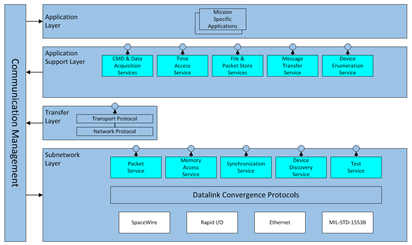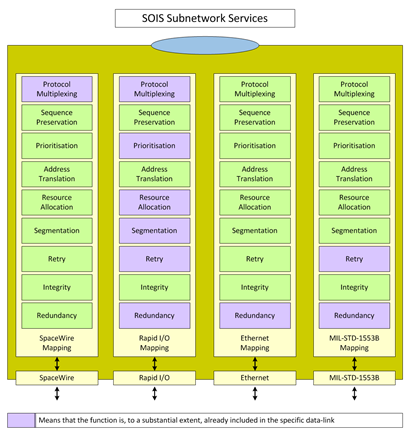Communication Profile
JAS CCSDS SOIS
The JAS communication architecture is based on the Consultative Committee for Space Data Systems (CCSDS) Spacecraft Onboard Interface Services (SOIS) reference communication architecture. SOIS describes a layered architecture that allows applications to be abstracted from the specific communication data links. The SOIS architecture describes four layers: the Application Layer, the Application Support Layer, the Transfer Layer, and the Subnetwork Layer as shown below.

JAS SOIS Reference Communications Architecture
The subnetwork layer provides services that system applications use to communicate over the data links. This profile currently focuses on three services: the Packet Service, the Memory Access Service, and the Synchronization Service. A brief description of these services is given below, and additional details on these services can be found in the Communication Specification.
- The Packet Service supports the transfer of data packets (messages) over a data link while presenting a consistent, uniform interface to applications.
- The Memory Access Service provides the capability to read from or write to a memory location or register in a device.
- The Synchronization Service provides the capability to send events to remote applications.
The subnetwork layer also provides Datalink Convergence Protocols for addressing Quality of Service (QoS) requirements. The figure below shows the set of QoS functions targeted by the SOIS standard for data links. It also shows which functions are natively provided by each data link standard. The definitions of these functions are:
- Protocol Multiplexing – allows multiple protocols to be simultaneously used on the network
- Sequence Preservation – guarantees the data is delivered in order
- Prioritization – allows data to be prioritized over the data link
- Address Translation – allows addresses to be translated from abstract to physical
- Resource Allocation – provides dedicated bandwidth to applications
- Segmentation – enforces a network Maximum Transmission Unit (MTU) size to promote fairness
- Retry – provides the capability to automatically retransmit if there is an error
- Integrity – provides an error detection capability
- Redundancy – provides the capability to try alternative paths of communications if one fails

JAS Implementation of SOIS Data Link Convergence Protocols
Additional communication protocols were developed for JAS to provide the functions that are not inherently provided by the data link standards shown above. These are described in more detail in the Communication Specification.